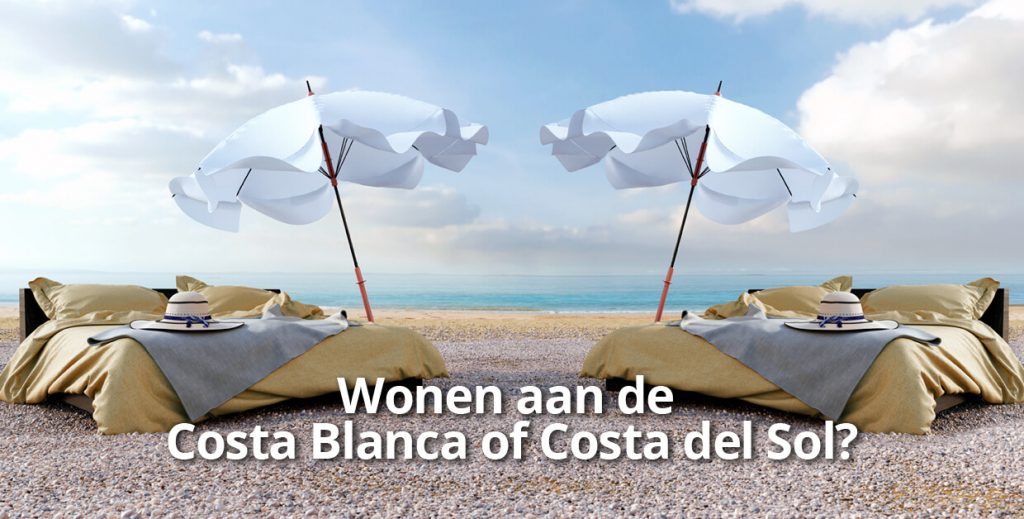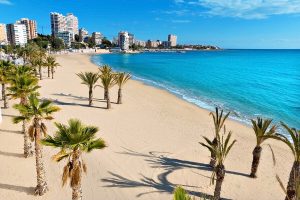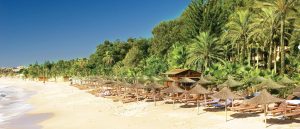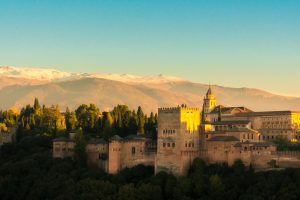Living on Costa Blanca or Costa del Sol? A comparison
18 Jan 2018
Spain's east and south coast has no fewer than eleven Costa's - from the Costa Brava on the border with France to the Costa de la Luz near Portugal, eleven strips of sun, sea, beach and big glasses of sangria that seemingly never run out.

Of those 11, Costa Blanca and Costa del Sol are by far the most popular for foreigners with Spanish dreams. Not difficult: the sun shines there more than 300 days a year, the atmosphere is warm and life runs several ticks slower. Where in Belgium that runs, there it saunters.
Why live on Costa Blanca or Costa del Sol?
The two coastal areas are especially popular because of their Mediterranean climate, their wide range of real estate and the infectious southern Spanish mañana lifestyle. You are not going to hear us argue that Galicia or the Basque Country, both in northern Spain, are not beautiful. On the contrary. But it does rain there as often as it does in Belgium. The choice is yours.
[caption id="attachment_1645" align="aligncenter" width="300"]

"When do we go swimming?" "Ah, mañana!"[/caption]
Perhaps your eye has also fallen on Spain. Possibly you want to move to yonder with all your belongings? Or have you rather set your sights on a country retreat, as a haven for summer getaways and weekends in the sun? You can do all that.
Those who are not yet at home in Spain sometimes ask us:
As a Belgian, where is it better to live - on the Costa Blanca or the Costa del Sol?
Even if you shoot us dead! We would love to have a ready-made answer to that question, but that's not how it works. Reality is not black and white, and there is no arguing about tastes and colors. However, we can make a comparison of these two coastal tourist areas of Spain, so you can make the conclusion for yourself.
First, we present the two options:
Option 1: Costa Blanca

The Costa Blanca - or white coast - is 244 kilometers long and has no fewer than 74 beaches. Most of them fly a blue flag, the independent seal of approval that indicates cleanliness. There are dunes, cliffs and rock formations, and inland a mountain range extends to the coast.
Between Denia and Pilar de la Horadada, tourists enjoy wonderful beaches, a friendly population, relaxed atmosphere and - of course - the sun all year round. Alicante is the capital of the Costa Blanca, a tourist gem.
In other words, were we to draw a picture of "heaven on earth," it would probably look pretty much like the Costa Blanca.
Option 2: Costa del Sol

Once the Costa del Sol was a string of small fishing villages, until nobles, celebrities, movie stars and wealthy businessmen began to make their way to Marbella and Torremolinos. Even Brigitte Bardot worked on her bronzing here.
Today, the region receives millions of tourists a year. The Costa del Sol - literally, the coast of the sun - equals 300 kilometers of coastline. From the cliffs of Maro in the east to Punta de la Chullera in the west, expats will find beautiful weather and Andalusian culture.
In fact, the Costa del Sol stretches along the Spanish provinces of Málaga, Cadiz and Granada, part of Andalusia. Fun fact: Of all European cities with more than half a million inhabitants, Málaga is the warmest. So the coast of the sun did not steal its name.
Climate
Climatically, there is little difference between the Costa Blanca and the Costa del Sol. Both areas have plenty of sunshine and pleasant temperatures in winter. On the Costa del Sol the sun shines at least 300 days a year, on the Costa Blanca even 320!
The sea water is warmer on the Costa Blanca than on the Costa del Sol, where the Atlantic Ocean provides cooling. The wind also makes summers there feel less oppressive than those on the Costa Blanca.
According to the World Health Organization, the climate of the Costa Blanca is the healthiest in the world.
And oh yes, if you want to cool down further on the Costa del Sol in winter, then ... you can go skiing in the mountains of the Sierra Nevada.
[caption id="attachment_1646" align="aligncenter" width="300"]

This, too, is Spain: skiing in the Andalusian mountains.[/caption]
Below we pour some statistics into a table and compare Alicante and Málaga, the main cities of Costa Blanca and del Sol, respectively. For reference, we also provide data from Ostend.
|
Alicante |
Malaga |
Ostend |
| Average temperature - January |
12°C |
13°C |
4°C |
| Average temperature - August |
26°C |
25°C |
17°C |
| Annual hours of sunshine |
2953 |
2905 |
1546 |
| Annual number of rainy days |
35 |
42 |
127 |
| Annual precipitation in millimeters |
277 |
534 |
762 |
| Average temperature - sea water |
19,6°C |
18,9°C |
12,7°C |
Valencia versus Andalusia
From Belgium, Spain looks like one big and homogeneous country, but in a previous blog post we wrote about its
diversity. Just as Flanders and Wallonia differ, no two Spanish provinces or regions are alike. A Basque is not a Balearic or Madrian, and a resident of Valladolid differs from one from Murcia. That diversity is just the beauty of Spain.
Valencia
The Costa Blanca forms the coastline of the province of Alicante, part of the autonomous community of Valencia. The capital of the same name is Spain's largest city after Madrid and Barcelona.
Many people here still speak Valencian. During Franco's dictatorship, that dialect was banned, but since 1982 locals have been allowed to chatter heartlessly in their own little language again. More to the point, Valencian is taught in school. This is why you often see names referred to in two variants. Don't panic: they also speak Spanish.
[caption id="attachment_1647" align="aligncenter" width="300"]

Signposts in Valencia are in two languages.[/caption]
The province of Alicante is best known for tourism. More famous than capital city Alicante is Benidorm. The old fishing village has become the most popular seaside resort in all of Europe. You may be thinking mostly of retirees in electric wheelchairs - and yes, there are some - but Benidorm also attracts younger couples and families. Not to mention the other coastal gems such as Calpe, El Campello or Torrevieja.
Andalusia
The Costa del Sol is located in Málaga, Cadiz and Granada, three of the eight provinces that make up Andalusia. Andalusia is the country's largest autonomous community. And what a one.
Living on the Costa del Sol gives you direct access to one of the richest cultures in Spain, if not in Europe. In this region, among others - take a breath - Iberians, Phoenicians, Greeks, Romans, Vandals, Visigoths, Byzantines, Jews and Muslim Moors left their footprints. Especially the legacy of the latter is great and well seen in the architecture of such cultural cities as Granada, Cordoba and Seville.
[caption id="attachment_1641" align="aligncenter" width="300"]

Alhambra in Granada: exponent of Moorish heritage in Andalusia.[/caption]
Andalusia has a strong identity. It is present in Granada, the ancient Moorish city, and in the always hot-tempered and flamboyant Seville, where the heartbeat of sensual flamenco beats loudest. Bullfights and rousing ferias also define this region. Culture lovers have an excellent base on the Costa del Sol. Sweat buffs should refrain, though, as the interior of Andalusia is the hottest area in all of Europe. Fortunately, on the Costa del Sol you escape the worst of the heat.
Buying on the Costa Blanca versus buying on the Costa del Sol
There are differences not only between buying on the Costa Blanca and on the Costa del Sol, but also within the two regions.
Let's start with the Costa Blanca.
The south of the Costa Blanca is the favored playground of expats, foreigners settling down in Spain. It is a succession of apartment buildings, villas, beaches, golf courses and restaurants offering fine dining.
That means prices there tend to be higher than elsewhere in the region. But: because there is so much real estate, there is still an occasional hit to be made.
It is worth paying attention though: not all properties are of the same quality. As a result, you risk buying
un gato en una bolsa, a cat in a bag. It is advisable to deal only with reliable real estate agents who have your best interests at heart.
[caption id="attachment_1644" align="aligncenter" width="300"]

No matter how cute, this is what you want to avoid: a cat in a bag.[/caption]
Head north from Benidorm - or further away from the coasts - and the atmosphere becomes increasingly Spanish. Here the Spaniards have their country houses. This region is less in the grip of tourism, less crowded and consequently there is more space. Prices tend to be a bit lower there. The further away from Benidorm and Alicante, the less you pay for housing.
Off to the Costa del Sol!
That coastal strip has always had a fancier image. This is where the world's beau monde loved to come and catch their breath. It's not hard to see why: great winter sunshine, world-class beaches and the rich culture of Andalusia at your fingertips. As a tourist, you have everything you need there.
Without wishing to generalize, on the other hand, prices on the Costa del Sol tend to be higher than those elsewhere in the country. Prices are also already closer to the limit as those on the Costa Blanca. As a result, there are fewer opportunities for profitable resale. That said, you may also be pleasantly surprised here.
As on the Costa Blanca, the further away from tourist wasps' nests like Málaga, Marbella and Torremolinos, the more value for money you get.
Accessibility
Alicante airport is the main gateway to the Costa Blanca. There are regular flights from Zaventem, Charleroi, Ostend and Liège. Flying to Murcia is also an option.
For the Costa del Sol, it is best to fly to Málaga, from Zaventem, Liège, Ostend or Antwerp.
Conclusion
Hopefully, with this comparative study, we have given you a solid boost. Before making a decision, it is advisable to move to yonder for a while. Rent a car and ... explore. This is the best and fastest way to discover which places make your heart beat the fastest.
In the meantime, of course, you can also contact us for free advice. Already chosen between Costa Blanca and Costa del Sol? Let us know and together we will look at the next steps.
 Of those 11, Costa Blanca and Costa del Sol are by far the most popular for foreigners with Spanish dreams. Not difficult: the sun shines there more than 300 days a year, the atmosphere is warm and life runs several ticks slower. Where in Belgium that runs, there it saunters.
Of those 11, Costa Blanca and Costa del Sol are by far the most popular for foreigners with Spanish dreams. Not difficult: the sun shines there more than 300 days a year, the atmosphere is warm and life runs several ticks slower. Where in Belgium that runs, there it saunters.
 "When do we go swimming?" "Ah, mañana!"[/caption]
Perhaps your eye has also fallen on Spain. Possibly you want to move to yonder with all your belongings? Or have you rather set your sights on a country retreat, as a haven for summer getaways and weekends in the sun? You can do all that.
Those who are not yet at home in Spain sometimes ask us:
"When do we go swimming?" "Ah, mañana!"[/caption]
Perhaps your eye has also fallen on Spain. Possibly you want to move to yonder with all your belongings? Or have you rather set your sights on a country retreat, as a haven for summer getaways and weekends in the sun? You can do all that.
Those who are not yet at home in Spain sometimes ask us:
 The Costa Blanca - or white coast - is 244 kilometers long and has no fewer than 74 beaches. Most of them fly a blue flag, the independent seal of approval that indicates cleanliness. There are dunes, cliffs and rock formations, and inland a mountain range extends to the coast.
Between Denia and Pilar de la Horadada, tourists enjoy wonderful beaches, a friendly population, relaxed atmosphere and - of course - the sun all year round. Alicante is the capital of the Costa Blanca, a tourist gem.
In other words, were we to draw a picture of "heaven on earth," it would probably look pretty much like the Costa Blanca.
The Costa Blanca - or white coast - is 244 kilometers long and has no fewer than 74 beaches. Most of them fly a blue flag, the independent seal of approval that indicates cleanliness. There are dunes, cliffs and rock formations, and inland a mountain range extends to the coast.
Between Denia and Pilar de la Horadada, tourists enjoy wonderful beaches, a friendly population, relaxed atmosphere and - of course - the sun all year round. Alicante is the capital of the Costa Blanca, a tourist gem.
In other words, were we to draw a picture of "heaven on earth," it would probably look pretty much like the Costa Blanca.
 Once the Costa del Sol was a string of small fishing villages, until nobles, celebrities, movie stars and wealthy businessmen began to make their way to Marbella and Torremolinos. Even Brigitte Bardot worked on her bronzing here.
Today, the region receives millions of tourists a year. The Costa del Sol - literally, the coast of the sun - equals 300 kilometers of coastline. From the cliffs of Maro in the east to Punta de la Chullera in the west, expats will find beautiful weather and Andalusian culture.
In fact, the Costa del Sol stretches along the Spanish provinces of Málaga, Cadiz and Granada, part of Andalusia. Fun fact: Of all European cities with more than half a million inhabitants, Málaga is the warmest. So the coast of the sun did not steal its name.
Once the Costa del Sol was a string of small fishing villages, until nobles, celebrities, movie stars and wealthy businessmen began to make their way to Marbella and Torremolinos. Even Brigitte Bardot worked on her bronzing here.
Today, the region receives millions of tourists a year. The Costa del Sol - literally, the coast of the sun - equals 300 kilometers of coastline. From the cliffs of Maro in the east to Punta de la Chullera in the west, expats will find beautiful weather and Andalusian culture.
In fact, the Costa del Sol stretches along the Spanish provinces of Málaga, Cadiz and Granada, part of Andalusia. Fun fact: Of all European cities with more than half a million inhabitants, Málaga is the warmest. So the coast of the sun did not steal its name.
 This, too, is Spain: skiing in the Andalusian mountains.[/caption]
Below we pour some statistics into a table and compare Alicante and Málaga, the main cities of Costa Blanca and del Sol, respectively. For reference, we also provide data from Ostend.
This, too, is Spain: skiing in the Andalusian mountains.[/caption]
Below we pour some statistics into a table and compare Alicante and Málaga, the main cities of Costa Blanca and del Sol, respectively. For reference, we also provide data from Ostend.
 Signposts in Valencia are in two languages.[/caption]
The province of Alicante is best known for tourism. More famous than capital city Alicante is Benidorm. The old fishing village has become the most popular seaside resort in all of Europe. You may be thinking mostly of retirees in electric wheelchairs - and yes, there are some - but Benidorm also attracts younger couples and families. Not to mention the other coastal gems such as Calpe, El Campello or Torrevieja.
Signposts in Valencia are in two languages.[/caption]
The province of Alicante is best known for tourism. More famous than capital city Alicante is Benidorm. The old fishing village has become the most popular seaside resort in all of Europe. You may be thinking mostly of retirees in electric wheelchairs - and yes, there are some - but Benidorm also attracts younger couples and families. Not to mention the other coastal gems such as Calpe, El Campello or Torrevieja.
 Alhambra in Granada: exponent of Moorish heritage in Andalusia.[/caption]
Andalusia has a strong identity. It is present in Granada, the ancient Moorish city, and in the always hot-tempered and flamboyant Seville, where the heartbeat of sensual flamenco beats loudest. Bullfights and rousing ferias also define this region. Culture lovers have an excellent base on the Costa del Sol. Sweat buffs should refrain, though, as the interior of Andalusia is the hottest area in all of Europe. Fortunately, on the Costa del Sol you escape the worst of the heat.
Alhambra in Granada: exponent of Moorish heritage in Andalusia.[/caption]
Andalusia has a strong identity. It is present in Granada, the ancient Moorish city, and in the always hot-tempered and flamboyant Seville, where the heartbeat of sensual flamenco beats loudest. Bullfights and rousing ferias also define this region. Culture lovers have an excellent base on the Costa del Sol. Sweat buffs should refrain, though, as the interior of Andalusia is the hottest area in all of Europe. Fortunately, on the Costa del Sol you escape the worst of the heat.
 No matter how cute, this is what you want to avoid: a cat in a bag.[/caption]
Head north from Benidorm - or further away from the coasts - and the atmosphere becomes increasingly Spanish. Here the Spaniards have their country houses. This region is less in the grip of tourism, less crowded and consequently there is more space. Prices tend to be a bit lower there. The further away from Benidorm and Alicante, the less you pay for housing.
No matter how cute, this is what you want to avoid: a cat in a bag.[/caption]
Head north from Benidorm - or further away from the coasts - and the atmosphere becomes increasingly Spanish. Here the Spaniards have their country houses. This region is less in the grip of tourism, less crowded and consequently there is more space. Prices tend to be a bit lower there. The further away from Benidorm and Alicante, the less you pay for housing.










